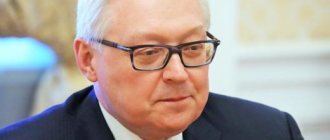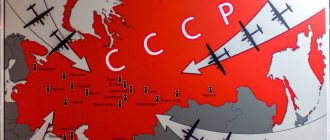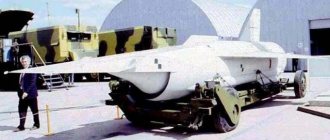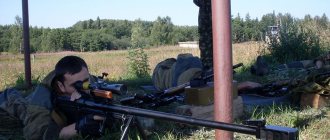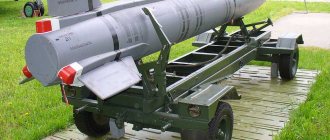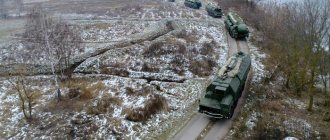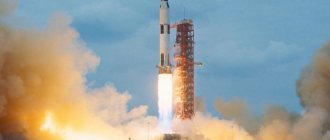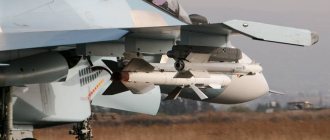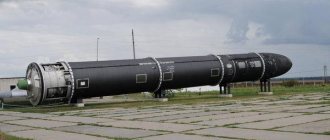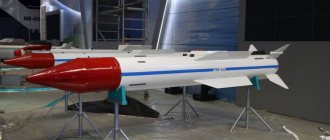The Russian military has adopted 217 strategic ballistic missiles over six years. This was announced by Defense Minister Sergei Shoigu, who spoke at an extended meeting of the State Duma Committee on Defense. Izvestia reminds how the grouping of domestic strategic nuclear forces (SNF) has changed.
According to Shoigu, since 2012, the Russian Strategic Missile Forces have received 109 Yars intercontinental ballistic missiles (ICBMs), and the naval component of the strategic nuclear forces has received 108 submarine-launched ballistic missiles (SLBMs).
It is obvious that Russia is actively rearming its strategic nuclear forces. Let's see how the domestic strategic grouping has changed, what it has come to and what lies ahead.
yars
Mobile ground-based missile system (PGRK) "Yars"
Photo: IZVESTIA/Alexander Kazakov
At the beginning of glorious deeds
Continuation of the series: what will be purchased under the state program
In 2022, new contracts for the supply of weapons for the Russian army and navy should be concluded
The starting point of our ceremonial portrait will be a completely official document: the Memorandum of Understanding to establish the baseline data within the framework of the START I treaty. In the fall of 1990, it recorded the detailed composition of the strategic offensive weapons groups of the USSR and the USA in order to implement the main idea of this agreement: to reduce the arsenal of strategic carriers by half. According to this protocol, the USSR at that time had 2,500 ICBMs, SLBMs and heavy bombers, with 10,271 nuclear warheads associated with them. We will not consider heavy bombers, since their share was relatively small and they had a weaker effect on strategic stability than missiles, but we will take into account that the United States had an advantage in them (574 aircraft and 2,353 associated warheads versus 162 and 855, respectively, for the USSR).
At the same time, the Soviet ground group belonging to the Strategic Missile Forces included 1398 ICBMs and 6612 warheads. It consisted of 1077 silo-based ICBMs (326 UR-100K, 40 RT-2, 47 MR-UR-100, 300 UR-100N (UTTH), 308 R-36M UTTH and R-36M2, 56 RT-23 UTTH), as well as 321 mobile missiles (288 Topols on a vehicle chassis and 33 RT-23UTTH as part of combat railway systems). The naval group of strategic nuclear forces consisted of 940 SLBMs (192 R-27, 280 R-29, 224 R-29R, 112 R-29RM, 12 R-31, 120 R-39) with 2804 warheads.
What do these numbers show? It is easy to see that, despite a slightly larger number of mobile missiles compared to stationary ones (1261 versus 1077), the latter carried 5994 warheads, that is, two-thirds of all nuclear weapons placed on strategic missiles. At the same time, just over half of all these stationary warheads accounted for just 308 heavy ICBMs.
poplar
Launcher "Topol" at the international military-technical forum "Army-2017"
Photo: RIA Novosti/Mikhail Voskresensky
The structure of the American missile force looked different. The United States had 1,000 ICBMs on land (450 Minuteman II, 500 Minuteman III, 50 Peacekeeper) with 2,450 warheads, and at sea - 672 SLBMs (192 Poseidon, 384 Trident I C4, 96 Trident II D5) with 5,760 warheads. That is, the mobile component in terms of warheads reached 70% of the entire group of ICBMs and SLBMs - a picture completely opposite to what we see in the USSR.
Tactical and technical data of the Satan missile
The R-36M "Satan" missile has:
- Two stages with expansion block;
- Liquid fuel fuel;
- The launcher, which is a silo, has a mortar launch;
- Power and number of used units: two monoblock versions; MIRV IN 8×550-750 ct;
- Head part weighing 8800 kg;
- With a light warhead with a maximum range of up to 16,000 km;
- With a heavy warhead with a maximum range of up to 11,200 km;
- With MIRV IN with a maximum range of up to 10,200 km;
- Inertial autonomous control system;
- Accurate hit within a radius of 1,000 meters;
- More than 36 meters long;
- The largest diameter is up to 3 meters;
- Launch weight up to almost 210 tons;
- Fuel weight up to 188 tons;
- Oxidizing agent: nitrogen tetroxide;
- Fuel - UDMH;
- The first stage thrust is up to 4163/4520 kN;
- The specific impulse of the first stage is up to 2874/3120 m/s.
Strategic Stability
What we have at Avangard: questions about new strategic weapons
There are still many gaps in the definition of the new complex
What is the meaning of these calculations? According to the prevailing ideas at the end of the 1980s, stationary silo missiles with a large number of warheads on board are destabilizing, that is, provoking the first use of nuclear weapons in the event of a military-political crisis. There are two reasons for this.
Firstly, by that time such missiles had already achieved very decent accuracy, which made it possible to confidently cover protected and buried targets on enemy territory with a relatively small number of warheads. This made them an excellent means of disarming, or “counterforce”, strike against nuclear forces.
Secondly, their coordinates were well known and thus they themselves were ready targets for enemy missiles - and the more warheads on one such missile can be knocked out by using only a couple of warheads, the more attractive the idea of “counterforce” becomes and the greater the fear that the missiles will be destroyed at the first opportunity. A “use-it-or-loose-it” dilemma arises, which in a crisis does not stabilize the situation, but, on the contrary, pushes the parties to a preemptive strike, so as not to “sleep through” a possible such strike from the enemy.
yars
Silo launcher (pictured) after the launch of the Topol-M strategic missile
Photo: TASS/Babenko Alexander
On the contrary, a large proportion of mobile missile systems (sea, road, railway) in the group ensures the uncertainty of the position of a significant number of warheads at any given time, which complicates the enemy’s task of preemptively destroying nuclear potential and guarantees the infliction of unacceptable damage in a retaliatory strike.
We ended up at Avangard: how and where they will deploy the new system
The first regiment of the new strategic complex will go on duty before the end of 2022
This achieves the opposite effect: in a crisis, the parties see that it is impossible to disarm the enemy with a first strike without receiving a full-scale response, therefore, instead of escalation, such structures of strategic groupings help (without guaranteeing) defuse the situation without provoking the use of nuclear weapons.
These considerations formed the basis of the 1990 Joint Consensus Statement, which first articulated the principle of strategic stability: eliminating incentives for a nuclear first strike. To achieve this, it was proposed to increase the share of assets in the group that have increased survivability in a retaliatory strike (that is, mobile systems), as well as to reduce the number of warheads on one missile, so as not to make it a tasty target for a preventive attack.
Combat use
Russia currently has 75 Satan ballistic missile systems in service. The missiles contain 750 nuclear warheads. In total, the Russian nuclear shield has more than 1,670 warheads, and half of them are “Satan”. But since 2015, some of the missiles of this modification are gradually being replaced by more modern combat missile systems.
The Satan has never been used in combat due to the fact that this very powerful deadly weapon can cause irreparable damage to the environment and humanity as a whole. The use of even one missile can lead to the disappearance, for example, of an entire state in the United States. In the mid-80s. The R-36M was massively replaced with improved units.
Instead of disposal due to its high cost, it was decided to use them to launch artificial satellites.
The R-36M is inaccessible to electromagnetic pulses, since the Voevoda control system is duplicated by pneumatic and electronic automatic weapons. To overcome the enemy's missile defense, "Satan" was equipped with decoys, both light and quasi-heavy, dipole reflectors and active jammers.
Thanks to the efforts of Soviet scientists and designers who worked on the creation of the Satan or Voevoda ballistic missile system, the most unique and powerful weapon on the planet was created. These intercontinental missiles are the pride of the Russian Strategic Missile Forces in our time.
Despite the enormous efforts made, potential adversaries of the Russian Federation have so far been unable to create anything comparable in power and efficiency. Russia need not fear for the safety of our Motherland and its inhabitants.
Logic, economics and politics
Beautiful, logical, understandable, modest. In 1993, the parties went even further: the START-2 treaty was signed, which was fully consistent with this philosophy. The parties pledged to eventually increase their nuclear arsenals to the level of 3–3.5 thousand warheads, with no more than 1,750 of them on naval missiles with multiple warheads (MIRVs). Ground-based ICBMs with MIRVs were completely prohibited (only monoblock ones were allowed), as well as heavy ICBMs in any configuration.
yars
Presidents George W. Bush and Boris Yeltsin at the signing of the START II treaty in the Kremlin
Photo: commons.wikimedia.org/Public domain
A weighty argument: how Russia will commission Sarmat missiles
Flight tests of the new rocket should begin in 2022
What do we see in this picture? In this picture we see a task that was completely unaffordable for the Russian economy of that period: it was necessary, in fact, to write off the entire Strategic Missile Forces group, except for the Topols, and compensate for this reduction with the increased production of new missiles, primarily naval ones (the agreement established separate ceilings for sea and land carriers, and not in favor of the latter). The Americans could simply scale up the existing group as part of general reductions.
Thus, the agreement, while progressive and abstractly correct in its logic and purpose, was absolutely unacceptable for Russia for resource reasons. It was necessary to look for compromise solutions that would reduce the burden on the economy and allow the majority of the historically established group to exist at least until the end of its service life. However, at that time Moscow could not obtain other conditions, and, it seems, did not try very hard.
The START-2 Treaty, as we now know, never really came into force, despite the fact that in 2000 the State Duma, after six years of resistance, was finally forced to ratify it. However, the denunciation of the ABM Treaty, which the United States announced in December 2001, completely buried this gesture, and START-2 faded into history, replaced by the Moscow START Treaty (2002), which was quite decent, but little binding in practice.
yars
As part of the START-2 treaty, the underground silo of the RS-18 intercontinental ballistic missile was blown up, 2002
Photo: TASS/Bushukhin Valery
The Limits of Nuclear Deterrence
Russia and the United States may return to the strategic arms race
However, in the 1990s, planning for the development of strategic nuclear forces in Russia was carried out on the basis that START-2 would nevertheless be put into force and implemented. In accordance with this, a new system of strategic missile weapons was selected. With the naval component, everything was more or less clear: project 955 “Borey”, for which they first wanted to adapt the R-39 UTTH “Bark”, and then they finally chose the “Bulava”. The Topol-M missile in silo and mobile versions was assigned to the ground group.
“Topol-M” was obtained by using the results of the development of a new ICBM on the “Universal” theme, which was carried out since the late 1980s by the Moscow Institute of Thermal Engineering and the Dnepropetrovsk Design Bureau “Yuzhnoye” (a unified silo-based and mobile-based solid-propellant missile). In the early 1990s, developments from Ukraine were transferred to Moscow, after which the entire scientific and technical basis was collected and brought into line with the new reality: components were localized in Russia and the technical appearance of the rocket was redesigned (originally it was supposed to be equipped with MIRVs, but on Topol-M » made a monoblock of a higher power class).
After the death of START-2, Russia, relying on earlier research and development, quickly created a new missile, partially inheriting the design of the Topol-M, but already equipped with a MIRV (presumably with three low-power warheads). This missile is now known as Yars; its first test launch was carried out in 2007, and already in 2009 it was put into service.
Now the Yars is the main missile of the Strategic Missile Forces; in its favor, the old Soviet-made Topolis, which are approaching the end of their service life, are being written off. In Kozelsk, on the basis of a missile division previously armed with UR-100N UTTH missiles, a formation of silo-based Yars has been deployed.
mace
Salvo launch of Bulava ballistic missiles from the submarine cruiser Yuri Dolgoruky
Photo: TASS
At sea, the bet was placed on the development of a new fifth-generation SLBM "Bulava". Since the selection of options and development took a long time, as did the construction of missile-carrying boats, an interim decision was made to modernize the existing arsenal. Thus, at the turn of the century, new combat equipment was created (R&D “Station”, “Station-2”) for missiles of the R-29R family, which were installed on boats of project 667BDR and 667BDRM. Subsequently, a fundamentally new missile R-29RMU2 (“Sineva”) was developed and put into serial production, and then R-29RMU2.1 (“Liner”) for Project 667BDRM boats.
“Topol” is laid up
The Ministry of Defense has reduced launch plans for these intercontinental missiles
However, the ultimate goal is to create a homogeneous naval group consisting of 14 Project 955 Borei missile-carrying boats equipped with Bulava missiles (eight boats under the 2011–2020 state weapons program and six under the 2018–2027 state program).
UR-100N (SS-19 Stiletto), Russia – 10,000 km
- UR-100N, according to the START treaty - RS-18A, according to NATO classification - SS-19 mod.1 Stiletto. This is a fourth-generation ICBM in service with the Russian Strategic Missile Forces.
- The UR-100N entered service in 1975 and is expected to be in service until 2030.
- Can carry up to six individually targetable warheads. It uses an inertial target guidance system.
- The missile is two-stage, silo-based. Rocket engines use liquid rocket fuel.
In stock
It is always difficult to get down to numbers in this area, since the Russian military does not spoil the public with too much publicity. However, relying on well-known open sources and Western research, we can estimate something.
At the moment, the Strategic Missile Forces group includes four types of missiles: R-36M2 (no more than 40–50 in the Dombarovsky and Uzhur position areas), “Topol” (about 50–60), “Topol-M” (18 mobile in Teykovo and 60 mine-based in Tatishchevo) and “Yars” (almost all available mobile divisions, as well as in the Kozel mines). “Yarsov”, as Shoigu told us, 109 units have been delivered since 2012, but Shoigu became the Minister of Defense in 2012, and the missiles began to arrive earlier - since the end of 2009. Thus, the latest collection of The Military Balance, based on data from about a year ago, claims that in total Russia at that time had 117 deployed missiles of this type: 103 mobile and 14 silo-based. Now there are probably more than 120 of them.
yars
Submarine of project 667BDRM "Dolphin" of the Northern Fleet of the Russian Navy at the pier in Gadzhievo, Murmansk region
Photo: RIA Novosti/Ramil Sitdikov
It is also customary to include the 30 UR-100N UTTH silo missiles remaining from the USSR into the Strategic Missile Forces grouping, however, according to Western experts, they have already been withdrawn from combat duty.
The naval group of strategic nuclear forces includes six Project 667BDRM "Dolphin" boats with 96 "Sineva" and "Liner" SLBMs, as well as three Project 955 "Borey" boats with 48 "Bulava" SLBMs. The fleet still has one boat of Project 667BDR “Kalmar” with 16 R-29RKU-02 (“Station-2”) missiles.
Drones will protect Yars and Topols
UAVs equipped with electronic reconnaissance systems will become the all-seeing eye of strategic missile systems
As of September 2022, the aggregated data transmitted by Russia to the United States under the New START Treaty looked like this: 517 deployed ICBMs, SLBMs and heavy bombers with 1,420 warheads. It is not difficult to see that Russia is underloading its missiles: if you count all available carriers at maximum load in blocks, you will get at least 1.6 thousand seats on missiles alone (possibly more, depending on the ratio of Sineva and Liners in the ammunition load project 667BDRM). This is completely normal, moreover, if control regimes are maintained, this practice will continue. The Americans practice this to an even greater extent: their Tridents, designed for 12-14 small blocks or 8 medium ones, now carry an average of 4-5 warheads, and the Minutemen have been converted to monoblock equipment, although their standard breeding platform can accommodate three warheads .
M51, France – 10,000 km
- The M51 is an intercontinental range missile. Designed for basing and launching from submarines.
- Manufactured by EADS Astrium Space Transportation for the French Navy. Designed to replace the M45 ICBM.
- The rocket entered service in 2010.
- Based on Triomphant-class submarines of the French Navy.
- Its combat range is from 8,000 km to 10,000 km. An improved version with new nuclear warheads is scheduled to enter service in 2015.
- The M51 weighs 50 tons and can carry six individually targetable warheads.
- The rocket uses a solid propellant engine.

